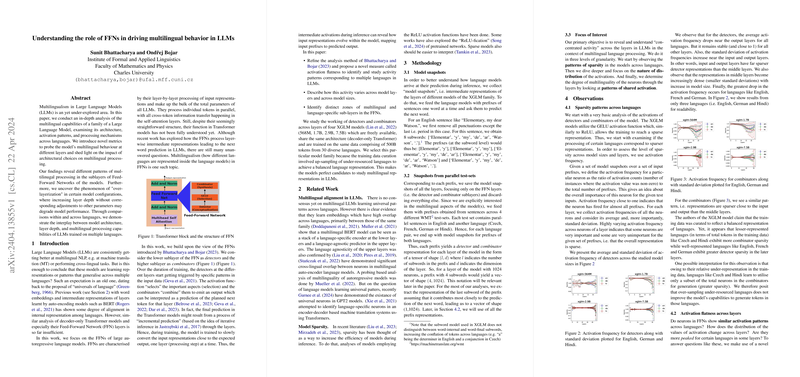The paper "Understanding the role of FFNs in driving multilingual behaviour in LLMs" offers a comprehensive analysis of how Feed-Forward Networks (FFNs) contribute to the multilingual capabilities of LLMs. The paper explores the architecture and activation patterns of a specific family of LLMs to understand the mechanisms underpinning multilingual processing.
Key Contributions
- Novel Metrics for Multilingual Analysis: The authors introduce new metrics specifically designed to probe the multilingual behavior of LLMs at various layers. These metrics enable a more granular examination of how different languages are processed within the model's architecture.
- Activation Patterns Across Languages: By analyzing the activation patterns within the FFNs, the paper sheds light on how different languages are handled by the model. The results show distinctive patterns of language processing, indicating that the FFNs play a pivotal role in handling multilingual tasks.
- Impact of Architectural Choices: The paper explores how various architectural decisions, such as layer depth and configuration, impact the multilingual capabilities of LLMs. One significant finding is the phenomenon of "over-layerization," where an increase in layer depth without proportionate adjustments to other parameters can degrade performance.
- Layer-Specific Multilingual Behaviour: The paper uncovers differing patterns of multilingual processing at different sublayers within the FFNs. This highlights that not all layers contribute equally to the model's ability to handle multiple languages.
Phenomenon of "Over-Layerization"
The term "over-layerization" refers to the negative impact on model performance that results from increasing the number of layers without corresponding changes to other architectural parameters. The paper finds that merely adding more layers can sometimes lead to diminished returns, or worse, a decline in performance. This is particularly relevant for multilingual models, where balanced architecture is crucial for optimal performance across various languages.
Findings and Implications
- Layer Depth and Multilingual Processing: The paper demonstrates that the relationship between layer depth and multilingual processing capabilities is non-linear. Beyond a certain point, additional layers may not contribute positively and could even hinder performance.
- Interplay between Architecture and Multilingual Abilities: By comparing models trained on multiple languages, the authors reveal a complex interplay between the model's architectural design and its multilingual processing prowess. This suggests that careful architectural tuning is essential for developing effective multilingual LLMs.
- Activation Insights: The analysis of activation patterns provides new insights into how different sublayers within FFNs process information across languages. This could inform better model design and training strategies.
Conclusion
The paper significantly advances our understanding of the role of FFNs in multilingual LLMs. It highlights the importance of considering architectural choices and provides new metrics for evaluating multilingual capabilities. The findings about "over-layerization" and the interplay between model architecture and multilingual processing offer valuable insights for researchers and practitioners aiming to build more efficient and effective multilingual models.
